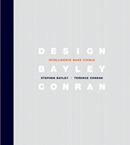A Life in Letters
Simon Heffer reviews a collection of letters by the author Graham Greene which sets out to provide a short cut to an understanding of Greene's complicated and highly charged life


Design: Intelligence Made Visible
Stephen Bayley and Terence Conran (Conran Octopus, £40)
The subtitle of this beautiful book, a quotation by Le Corbusier, is used by Conran to justify his position (right in my view) that good design is 98% common sense and 2% art. Everything we make, he says, is also designed, con-sciously or unconsciously, from the flint arrowhead to the Cruise missile to the way we place food on a plate. The best designs, such as old Levi jeans, good shoes (or, he could add, this book) are both innovative and long lasting.
The first eight chapters consider the influences of mass consumption, design in America and Italy (where, incredibly but tellingly, there are fewer art schools than Cheshire) and design since the 1980s. This turns out to be a lament for lost integrity. Designers such as Eames and Rams 'aimed to improve, to invent, to beautify', whereas today, 'no longer is the designer helping to edit dross from the universe, he is contributing to the excess'. And, even more savagely: 'Anyone who can rag-roll an old Irish pine dresser claims the title (of designer).' That Conran and Bayley unwittingly contributed to this is ironic.
The core of the book is a survey of the designers, designs and enlightened manufacturers of the 20th century, from Aalto to Zanuso although I'm not sure how Josiah Wedgwood qualifies here. The profiles are often accompanied by the designers' inspirations: a horse blanket (Magistretti's Sinbad chair for Cassina) a pile of old tyres (Bibendum for Michelin) and a baseball glove (the Joe chair by De Pas, D'Urbino and Lomazzi).
The tenets of designers are also quoted: I particularly like aircraft designer Kelly Johnson's 'be quick, be quiet, be on time' for its good sense, together with Charles Eames's view that 'we have to rediscover limitations', as anyone who has designed a newspaper page around advertisements quickly finds out.
The authors can be fierce. I agree with their view that Tord Boontje's work is kitsch, but not that Starck's Ghost chair is annoying. I agree even more strongly that the age of the celebrity designer has encouraged 'attention-seeking frivolity...feckless neophilia'. 'Designers today...are busy inventing things we do not need to buy with money we do not have to impress people we have not met.' Designers were far more influential when they were less known, they suggest.
Sign up for the Country Life Newsletter
Exquisite houses, the beauty of Nature, and how to get the most from your life, straight to your inbox.
Weighty (in both senses), wise and witty, this should be essential reading for everyone involved with design. That means all of us.
Country Life is unlike any other magazine: the only glossy weekly on the newsstand and the only magazine that has been guest-edited by HRH The King not once, but twice. It is a celebration of modern rural life and all its diverse joys and pleasures — that was first published in Queen Victoria's Diamond Jubilee year. Our eclectic mixture of witty and informative content — from the most up-to-date property news and commentary and a coveted glimpse inside some of the UK's best houses and gardens, to gardening, the arts and interior design, written by experts in their field — still cannot be found in print or online, anywhere else.
-
 Athena: We need to get serious about saving our museums
Athena: We need to get serious about saving our museumsThe government announced that museums ‘can now apply for £20 million of funding to invest in their future’ last week. But will this be enough?
By Country Life
-
 Six rural properties with space, charm and endless views, as seen in Country Life
Six rural properties with space, charm and endless views, as seen in Country LifeWe take a look at some of the best houses to come to the market via Country Life in the past week.
By Toby Keel